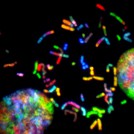T Cell-based Reporter Gene Assay
Due to the specificity and flexibility of the reporter gene expression method, Creative Biolabs offers innovative and high-throughput reporter gene-based cancer epitope identification and characterization assays to monitor T-cell responses.
Applications of Reporter Gene-based T-Cell Assay
Reporter gene-encoded protein is used by researchers for the indication of the gene of interest expressed naturally or a transgenic gene fusion to the target genome successfully. The reporter gene is widely employed in various studies on cell-level and animal levels to explain the complex process. IL-2 secretion is a selective marker for activated T cells and is often used as an indicator of antigen-specific T cell activation. Other reporter genes, such as GFP and luciferase, are integrated under the control of human promoters to monitor T cell responses.
 Fig.1 Antigenic epitope identification by APC cytokine capture.2
Fig.1 Antigenic epitope identification by APC cytokine capture.2
Reporter Gene-based Epitope Analysis Services at Creative Biolabs
Creative Biolabs provides various bioassays for cancer epitope analysis and assessment. Here, we present a reporter gene-based T-cell assay to identify class I- and class II-restricted epitopes.
Workflow

Main Steps of the Particular Assay
Peptide Library Generation
-
A peptide library generated from ORF of the cancer antigen.
-
Overlapped peptides library design and synthesis.
Construction of APCs Cells
-
Knocking out MHC I and/or II molecules in APCs.
-
Transduce peptide-HLA sequences to APCs.
-
Transduce anti-cytokine antibody encoding sequences to APCs.
T Cells Generation
-
Stimulate PBMC with cancer antigen protein in vitro.
-
Expressing specific TCR on T cells.
Screen Immunogenic Epitope
-
Engineered APCs are co-cultured with T cells in various ratios.
-
Capture cytokine-APC binding complex by fluorescent-labeled antibodies.
-
Detect by flow cytometry.
Key Features and Advantages of the Assay
-
High-throughput Epitope Identification System
A large DNA-encoded epitope library is generated on live cells other than synthesized peptide, saving much research budget for displaying epitopes.
-
Combine Both Epitope and HLA Diversity
Our assay concurrently tests both MHC class I and class II and multiple HLA alleles presented antigen peptides.
-
Simple and Easy for Detection
Monitor T-cell activation-dependent cytokine release by a simple flow cytometric assay without advanced kits.
-
Comprehensive Epitope Analysis
Identify the antigenic epitope and analyze by NGS (Next-generation Sequencing).
Map cancer epitopes using overlapped small peptides library of the protein.
Applications of the Assay
-
Select Immunogenic Epitopes of Pathogens
-
Isolate Epitope-Specific T Cells
-
Identify Epitope Binding TCR Sequences
Creative Biolabs is an oncology research consultancy and experimental service provider. With many years of experience in cancer study, Creative Biolabs offers clients the most suitable solutions with premium quality and efficiency. Please contact us for more information.
References
-
Fu, Z.; et al. A reporter gene assay for determining the biological activity of therapeutic antibodies targeting TIGIT. Acta pharmaceutica Sinica. B. 2021, 11(12): 3925–3934.
-
Lee, M. N.; Meyerson, M. Antigen identification for HLA class I- and HLA class II-restricted T cell receptors using cytokine-capturing antigen-presenting cells. Science immunology. 2021, 6(55): eabf4001.
For Research Use Only | Not For Clinical Use


 Fig.1 Antigenic epitope identification by APC cytokine capture.2
Fig.1 Antigenic epitope identification by APC cytokine capture.2






 Download our brochure
Download our brochure